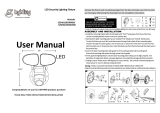
TROUBLESHOOTING
During the sensor warm-up period, which can last up to a minute
after power is applied to the power module (or after a power
outage of 5 minutes or more), the load can be either ON or OFF,
depending on the status of the relay before the sensor was
powered down. After warm-up, the sensor will open or close the
relay to correspond to the occupancy status of the room.
To quickly test the unit, turn the time delay to minimum. Wait for
the warm-up period to end. Move out of the sensor’s view. Lights
should turn OFF after 30 seconds. Move into the sensor’s view.
The sensor’s Red LED should blink and the lights should turn ON.
Red LED on power module does not blink:
Check sensor wire connections. Verify the
neutral wire is tightly secured.
Red LED blinks but lights do not turn ON:
1. Make sure that power to the sensor has been ON
continuously for at least one minute, then
a) Turn OFF power to the sensor.
b) The relays will close.
c) Turn ON power to the sensor.
d) The loads should come ON. If not, continue with 2 below.
2. Check power connections to the light fi xture.
3. Check all sensor wire connections. Verify
the load wire is tightly secured.
Lights will not turn OFF:
1. If there is no motion from people or equipment in the
sensor’s view but the red LED blinks, look for any nearby
source of IR energy in motion, such as turbulent air from
a heating or cooling supply, or other sources. Divert the
air supply away from the sensor, or move the sensor.
2. Verify time delay. The time delay can be set from 15
seconds to 30 minutes. Ensure that the time delay is
set to the desired delay and that there is no movement
within the sensor’s view for that time period.
3. Check DIP switch 8 setting. If it is ON, it overrides
the PIR function and keeps the load ON.
4. Check sensor wire connections. Verify
load and neutral wires are secure.
ORDERING INFORMATION
Catalog # Description
HB350T*-L#+ High bay line voltage occupancy sensor
consists of:
• HB350T Power Module
• An HBL# lens (L# indicates the lens number)
(see COVERAGE GUIDE)
HBNB3 Back box with 2 chase nipples and nuts;
1 short (0.88”) for connection to plastic,
1 long (1.24”) for connection to metal
HBEM3 Extender module with 2 chase nipples and nuts
1 short (0.88”) for connection to plastic,
1 long (1.24”) for connection to metal
* See available feature suffix indicators below:
C is for colder ambient temperature applications:
-40° to 131°F (-40° to 55°C)
+ an additional -B suffix includes the HBNB3 back box
All units are White.
WARRANTY INFORMATION
Watt Stopper/Legrand warranties its products to be free of
defects in materials and workmanship for a period of five
(5) years. There are no obligations or liabilities on the part
of Watt Stopper/Legrand for consequential damages arising
out of, or in connection with, the use or performance of this
product or other indirect damages with respect to loss of
property, revenue or profit, or cost of removal, installation or
reinstallation.
2800 De La Cruz Boulevard, Santa Clara, CA 95050
Technical Support: 800-879-8585
www.wattstopper.com
07788r1 1/2007
Call 800-879-8585 for Technical Support




